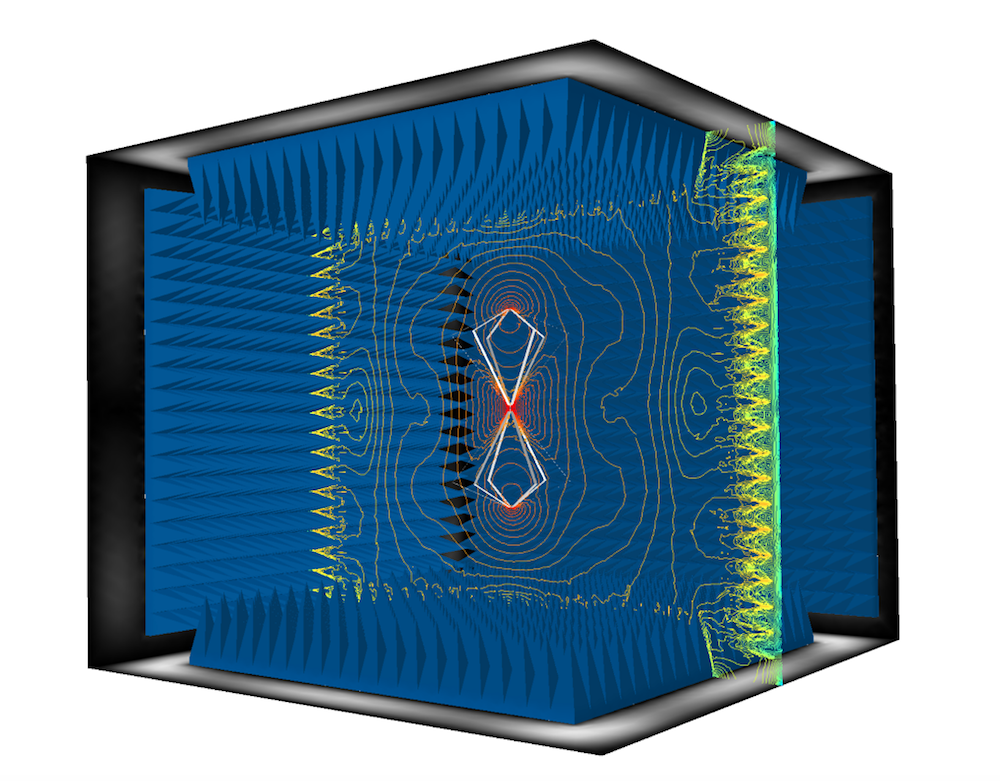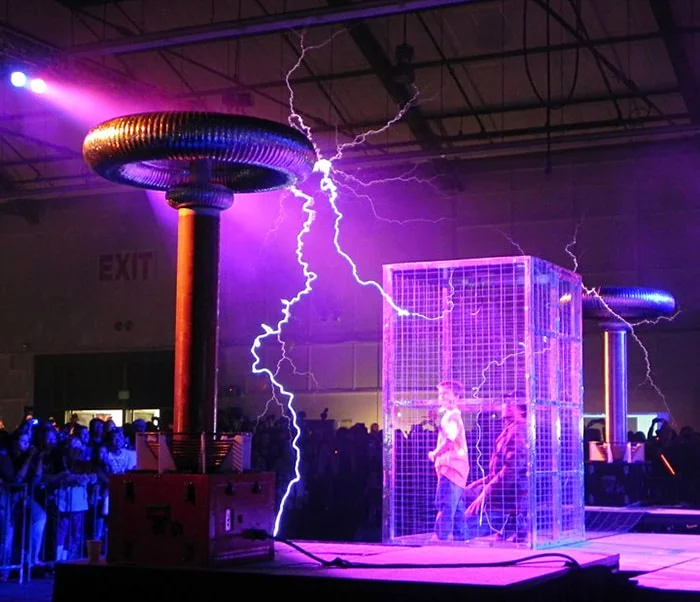Imagine a shield capable of blocking electromagnetic radiation, protecting sensitive electronics, and ensuring accurate scientific measurements. This powerful barrier is not a product of science fiction but a reality known as the Faraday cage. Let’s explore the fascinating world of Faraday cages.
Key Takeaways
- Faraday cages are conductive shields that protect enclosed devices from electromagnetic radiation.
- Common materials used in construction include wire mesh, metallic sheets, and aluminum foil.
- Faraday cages protect EMPs and can be tailored to sustain wireless connectivity with the right shielding material & grounding.
The Downside
- They don’t work very well for human beings.
- You need to be inside the cage for it to work.
- You can’t have electronics inside the cage.
- It’s not practical for your life unless you use it to sleep or meditate.
A Portable, Practical Alternative to a Faraday Cage
Let’s face it: life inside a Faraday Cage isn’t practical or comfortable. The Giffy here shows the protective vortex the BioElectric Shield puts around you
Our BioElectric Shield EMF Pendant is beautiful and stylish, and it will accompany you 24/7 as you live your best life.
Since 1994, BioShield has been protecting people from EMF and other energies, such as other people’s stress and negativity.

The Science Behind Faraday Cages
The magic of Faraday cages lies in their ability to redistribute electric charge on their conductive surface, thus shielding against electromagnetic radiation and preventing interference with enclosed devices. When exposed to an electric field, charges remain on the exterior of the conductor, creating a net electric field of zero inside the Faraday cage. The effectiveness of a Faraday cage in shielding against various types of electromagnetic radiation, including visible light, depends on the thickness of the conductor and the size of any holes in the cage. The thicker the conductor and the smaller the holes, the better the protection against electromagnetic radiation.
The use of a Faraday cage can reduce interference from electromagnetic radiation, utilizing its magnetic properties to obstruct external magnetic fields. The ground connection of a Faraday cage establishes an equipotential bond between the cage and its environment, eliminating any voltage and subsequent field between them, neutralizing surplus charges. The efficacy of a shield in weakening electromagnetic fields is significantly determined by its thickness; a thicker shield can effectively attenuate fields of lower frequencies.

The Inventor and Evolution of Faraday Cages
The originator of the Faraday cage was none other than Michael Faraday, a renowned scientist known for his contributions to electromagnetism. Faraday built the first Faraday cage in the 19th century, using a room lined with metal foil and bombarded with electricity generated by an electrostatic generator. His observations led to the discovery that excess charge on a charged conductor was only present on its exterior and had no effect on anything enclosed within it.
This pivotal discovery has progressed over time, with modern Faraday cages finding utility in multiple industries. The foundational concept remains unchanged: redistributing charges on a conductive surface for protection against electromagnetic radiation, ensuring enclosed devices are safeguarded from interference.


Materials and Construction of Faraday Cages
Various conductive materials like wire mesh, metallic sheets, or wire coils can be used to create Faraday cages. The choice of material depends on the wavelength of the electromagnetic radiation, such as radio waves, to be blocked and the level of exclusion required. Thicker conductors offer better protection against electromagnetic radiation.
For example, a thicker outer covering of a Faraday cage offers heightened protection against stronger electric fields.
Continuous vs. Non-Continuous Shields
A continuous Faraday shield is essentially a hollow conductor, while a non-continuous Faraday shield is a Faraday cage or shield that has breaks or gaps in its structure. Continuous shields are more effective at providing a barrier against electromagnetic radiation, while non-continuous shields have gaps that allow certain wavelengths to pass through.
The size of the openings in a non-continuous Faraday shield is usually determined by the wavelength of the electromagnetic waves that need to be blocked. Generally, the openings should be smaller than 1/10th of the wavelength for effective shielding. This difference is significant when choosing the right shield for a particular application.

Everyday Examples of Faraday Cages
Common examples of Faraday cages include a phone wrapped in plastic and aluminum foil, microwaves, and MRI scanners. These practical uses range from safeguarding sensitive electronic equipment from electromagnetic interference to providing a shield against electric currents like lightning strikes and electrostatic discharges.
A car can also act as a partial Faraday cage during a lightning strike, with its exterior conducting electricity and shielding from electric charges related to the strike. However, cars are not ideal examples of Faraday cages due to the presence of rubber tires and openings that permit some electromagnetic radiation to pass through.
Faraday Cage Applications and Benefits
Faraday cages provide multiple benefits, like shielding sensitive electronic equipment from electromagnetic interference and protection against EMPs. Faraday cages are widely used across industries, including power plants, law enforcement, and scientific research, serving to block electromagnetic fields and secure electronic devices. In medical imaging, such as MRI machines, the scan room is designed as a Faraday cage to protect the accuracy of the data collected from the patient.
Faraday cages play a vital role in scientific research and experiments, blocking electromagnetic fields and protecting equipment and measurements from external electrical charges or radiation. They are typically constructed from conductive materials such as copper, aluminum, or steel, which distribute and cancel out electric charges or radiation around the cage’s exterior.
Moreover, Faraday cages provide protection against electromagnetic pulse (EMP) attacks by constructing a shield of conductive material that blocks the electromagnetic waves from entering the enclosure. The cage acts as an effective barrier, redirecting the electromagnetic energy around the protected devices and thus preventing them from being damaged or disrupted by the EMP.
Building Your Own Faraday Cage
Creating a DIY Faraday cage involves enclosing a device using a conductive material, with different options available based on the level of protection required. Materials such as:
- Wire mesh
- Metal
- Aluminum foil
- Chicken wire
can be used to construct a Faraday cage. Additionally, a sturdy frame made of wood or plastic is recommended to provide support and structure for the cage.
One method to construct a Faraday cage at home involves:
- Covering the electronic device with alternating layers of materials like aluminum foil and insulating materials.
- Alternatively, a galvanized metal trash can with a tight-fitting lid can be utilized.
- It is essential to ensure that all seams are overlapped and sealed with regular cellophane tape to create a complete enclosure.
Grounding and Safety Considerations
Correct grounding of a Faraday cage is vital for safety, ensuring the safe exit of electric charges without causing harm. The most effective approach for grounding a Faraday cage is to:
- Use a solid metal plate for grounding.
- Ensure that the ground wire does not enter the cage.
- Use filters and bypassing techniques to further improve the grounding effectiveness.
The materials most commonly used for grounding a Faraday cage include:
- Copper mesh
- Metal mesh
- Solid copper
- Solid steel
It is essential to ensure that the grounding material, a type of conducting material, is conductive and provides a path for the charge to be discharged from the cage.
Legal and Ethical Aspects of Faraday Cage Usage
Although Faraday cages are generally legal, their use to intentionally block signals, like mobile phones, might be illegal in certain jurisdictions. Faraday cages are legal and regularly employed in multiple industries to block electromagnetic fields and secure electronic devices. It is essential to guarantee that the utilization of a Faraday cage does not breach any specific regulations or laws in the applicable jurisdiction.
Ethical concerns regarding privacy, security, accessibility, and equity may also arise in the context of Faraday cage usage.


Faraday Cages and Wireless Connectivity
Faraday cages can obstruct Wi-Fi signals, rendering them unsuitable for use near wireless routers and other devices connected to the internet. When a Faraday cage is placed around an Internet router, it prevents the electromagnetic radiation from escaping, thus inhibiting access to the Internet.
There exist scenarios where Faraday cages do not hinder wireless connectivity. For instance, if the Faraday cage is tailored to permit certain frequencies to pass through while obstructing others, it can still sustain wireless connectivity. Furthermore, if the Faraday cage is properly grounded and has suitable shielding materials, it can reduce interference and sustain wireless connectivity.
Protecting Against Electromagnetic Events
Faraday cages can provide protection against EMPs originating from both artificial and natural sources like solar flares, but they require thick conductive walls and minimal holes to be effective. Faraday cages provide protection against electromagnetic pulses from both natural and man-made sources by forming a shield of conductive material around the exterior of the cage, thereby preventing the electromagnetic pulses from entering the interior and damaging the electronics therein.
Design considerations for constructing Faraday cages to block EMPs include:
- Ensuring that openings are smaller than 1/10th of the wavelength that needs to be blocked
- Forming a continuous electrical shield that completely surrounds the device, room, or building
- Providing penetration protection for all power, data, and antenna cables to make the equipment behind the Faraday cage safe from EMPs.
Alternatives to Faraday Cages
Not everyone has the means to make their own faraday cage. Moreover, there are practical issues that many do not want to deal with. In the event you would like to protect yourself with alternative products, you can consider our signature product, our Shield EMF Pendant.
Summary
In summary, Faraday cages are powerful shields that offer protection against electromagnetic radiation in various applications, from everyday life to scientific research and industry. These cages work by redistributing charges on their conductive surface, effectively shielding enclosed devices from interference. The effectiveness of a Faraday cage depends on factors such as the thickness of the conductor, the size of any holes, and proper grounding.
Understanding the science behind Faraday cages, their numerous applications, and the different materials and construction methods used to create them, we can appreciate these fascinating shields’ potential benefits and uses. As the world increasingly relies on electronic devices, the importance of Faraday cages will continue to grow, ensuring our devices remain safe and secure from electromagnetic events.
Frequently Asked Questions
What does a Faraday cage do?
A Faraday cage protects static and non-static electromagnetic fields against potentially harmful interference.
Can aluminum foil be used as a Faraday cage?
Yes, aluminum foil can be used to create a Faraday cage. It is a conductive material; you can test its functionality by ringing a phone inside it.
Will any metal box work as a Faraday cage?
Yes, metal boxes can work as Faraday cages if designed for good electronic shielding and have electrical contact between the sides and door edges.
Does a Faraday cage protect against EMP?
Faraday cages and other shielding enclosures constructed from conductive material protect against EMP damage. These enclosures create an electromagnetic shield around the bag’s contents that blocks electromagnetic fields.
What materials can be used to construct a Faraday cage?
Wire mesh, metallic sheets, or wire coils can be used to construct a Faraday cage.
What’s Practical in Your Life?
Live in a Faraday Cage or Wear a BioShield that Protects you 24/7, wherever you are.
If you’re like me and prefer wearing a Shield that weighs only a few ounces, then take the next step and order protection today.
Take our Quiz for a recommendation based on your EMF Exposure and Risk levels.


0 Comments